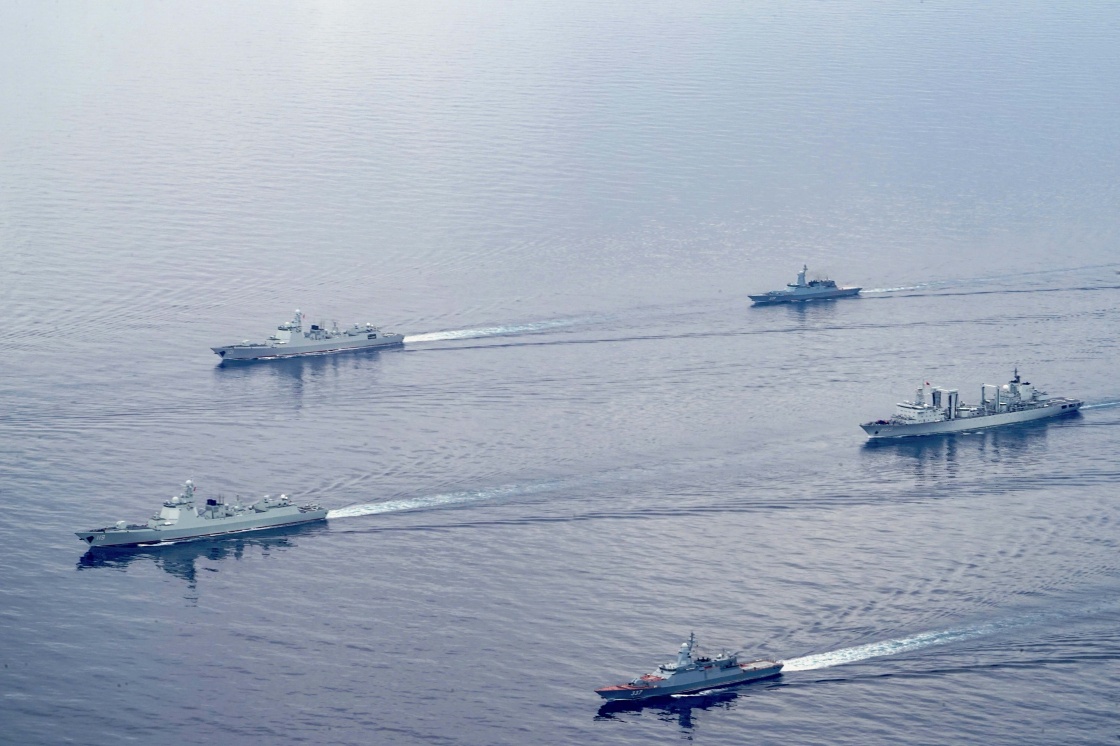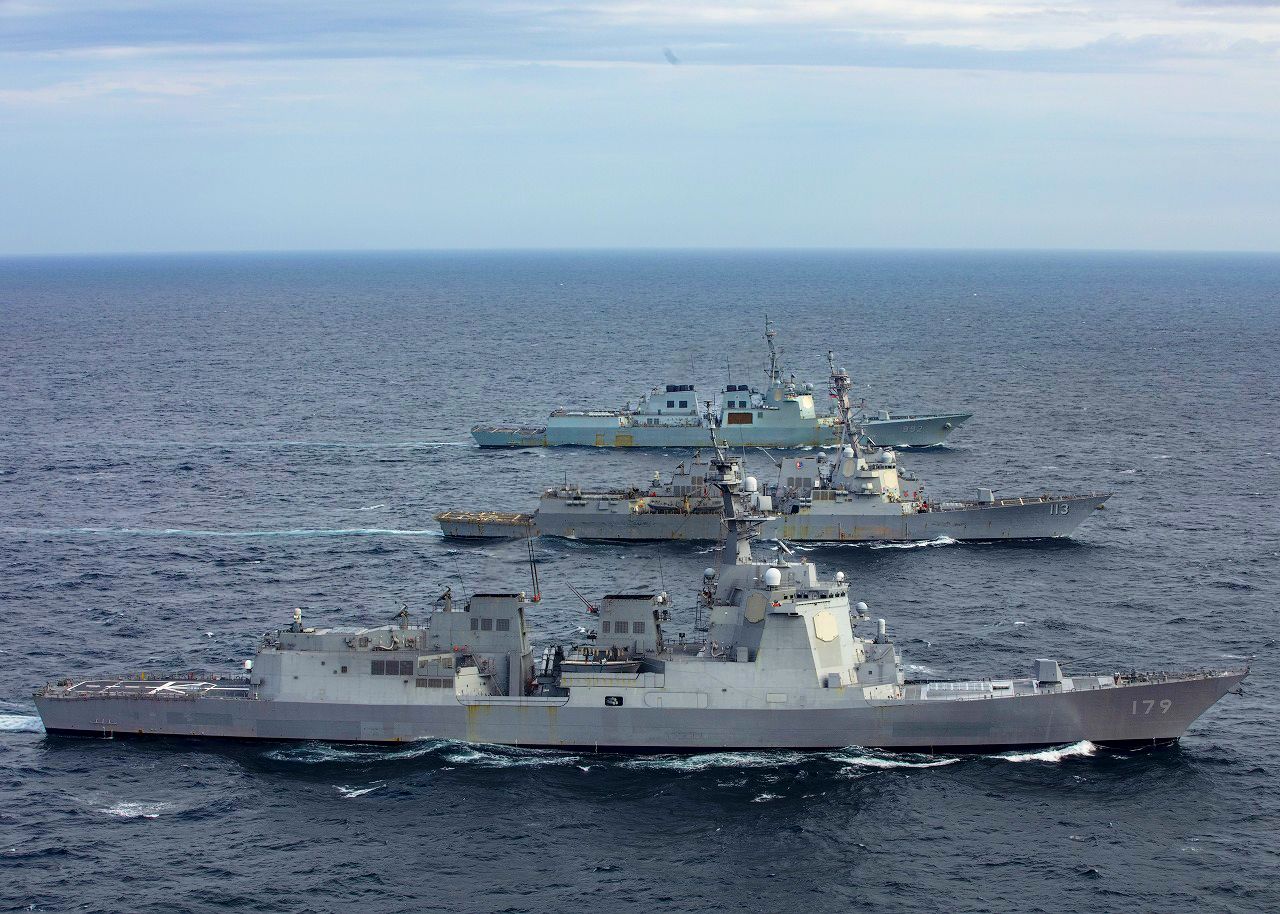Russia and China’s naval drills in the Sea of Japan have ominous signals for the US-led Western alliance that has identified the two nations as threats, further aligning their military and strategic visions.
MUST READ: China Completes 10 Years Of $1.4 Trillion BRI Project; Puts South Asia, Barring India & Bhutan, In A Bind
Moreover, they also reveal chinks in the military armor and weak links in the political grouping Washington is shoring up against Russia, North Korea, and China.
Coming after the US, Japan, and South Korea’s trilateral missile defense drills earlier this week in response to North Korea’s launch of its Hwasong-18 Intercontinental Ballistic Missile (ICBM), it marks the most tense military situation in far east Asia.
Moreover, as the war in Ukraine enters its fifteenth month, where Kyiv has very little to show for militarily with a failing counteroffensive, it has only strengthened Moscow’s, Beijing’s, and Pyongyang’s strategic position.
The naval exercises, called Northern/Interaction-2023, commenced on July 20 and will last until July 23. With ten vessels from Russia’s Pacific Fleet and China’s Northern Theater Command (NTC), a highlight of the maneuvers is Chinese warplanes operating from a Russian airfield.
The joint exercises featured anti-submarine missions, naval combat, sea and air escort of ships, guarding and defending detachments of ships when moored in an unprotected roadstead, and ensuring the security of communications in and over the Sea of Japan, the Russian Ministry of Defense (RuMoD) said.
What The Drills Practiced
China’s People’s Liberation Army Navy (PLAN) was represented by Type 052D guided missile destroyers Qiqihar and Guiyang, the Type 054A guided missile frigates Zaozhuang and Rizhao, and the Type 903 comprehensive replenishment ship Taihu.

These rendezvoused with the large anti-submarine ships Admiral Tribunts and Admiral Panteleev, as well as the corvettes Gremyashy and Hero of the Russian Federation Aldar Tsydenzhapov in the designated waters in the Sea of Japan on Tuesday after setting out from Qingdao, East China’s Shandong Province on Saturday.
The aerial component sees more than 30 aircraft, including fighter jets, anti-submarine aircraft, and helicopters. China Central Television reported that the Chinese side had deployed the Y-20 large transport aircraft, the KJ-500 early warning aircraft, the J-16 fighter jet, and the Z-20 helicopter to Vladivostok in Russia’s Far East as part of the exercise.
According to a leading Chinese military expert, Chinese aircraft operating from Russian airfields marks a high level of military cooperation and mutual trust between the two countries.
The RuMoD gave a detailed account of the type of military roles and functions the two navies undertook, which marks greater familiarization and a semi or ad-hoc interoperability, particularly with the posting of their personnel on the other’s warships, as was seen in the promotional videos.
On June 21, the ships destroyed a naval floating mine; repelled an attack by a small-sized target; improved their navigation skills in various formations; and conducted communications training. Russian warships practiced naval combat with a mock enemy ship, firing at a sea target with 100mm Ak-100 and A-190 artillery systems.

The large Anti-Submarine Warfare (ASW) ship Admiral Tributs destroyed the mock-up floating sea mine with a heavy machine gun. Interestingly, they also repelled an attack by a high-speed small-sized target, similar to the sea kamikaze drones Russia’s Black Sea Fleet faces.
The fleets also undertook “joint convoying” of ships and vessels in a contested area by protecting the convoy from enemy vessels. “Sailors of the two countries, as part of the exercise to ensure the safety of navigation in remote areas of the world ocean, carried out sea and air convoy tasks of ships and vessels. The issues of organizing reliable anti-aircraft, anti-ship, and anti-submarine defense of the joint detachment were worked out,” a RuMoD statement said.
The Strategic Signaling
According to Stephen Nagy, a regional security expert at the International Christian University, Russia and China are trying to convey to Japan and the US that they are very unhappy with their cooperation in NATO and the (Indo-Pacific) region. “They want to prove that they can achieve the same level of cooperation in the region as Washington and its allies,” Nagy was quoted in an article on Voice of America (VOA).
For Russia, Nagy said the drills show “that they still have the capacity to manage conflicts on the eastern front but also provide capabilities to the Indo-Pacific region to work with China and pressure the US.”
Russia, too, is an Indo-Pacific nation, sharing the same contiguous geography in the western Pacific where China faces the US, Japan, and Taiwan.
The region is considered a major tinder box that can trigger another world war because of the presence of three major flashpoints – the Korean Peninsula, the Taiwan Straits, and the South China Sea (SCS).
Moreover, China is a party in all three conflicts, and an unrestricted face-off in anyone can engulf the other two.
Russia also has diplomatic and territorial tensions with Japan in the far east Asian region. This comes from Tokyo’s critical stance on Moscow over the Ukraine war and contesting claims over the Kuril islands.
The US, Japan, and South Korea recently conducted a trilateral missile defense drill in the Sea of Japan to counter North Korea’s nuclear missile threats. NATO has also forayed into the region and is now targeting China and teaming up with Taiwan.
Thus, Moscow and Beijing convey that they are unhappy at being unnecessarily provoked outside their borders.
A tweet by former Global Times editor Hu Xijin gave an insight into the larger strategic and military thinking of the two countries’ leadership behind holding the drills.
“It’s a part of the two countries’ normalized and institutionalized military cooperation. The Sea of Japan is strategically important for both sides; thus, the drills are highly targeted,” Hu said.
“Cooperation” here essentially backs the other up without actually fighting on its behalf in a non-legally binding military alliance. Here, Russia or China facing the US alliance in a conflict, can rely on the other to create military pressure on Washington and its allies not to escalate the war.
How It Plays Out
So, for instance, in the event China clashes with the United States during a Taiwan contingency, the US will be constrained to bring in the combined South Korean and Japanese naval might, not only because they will become legitimate targets for Beijing and escalate the war, but also because Russia too views the grouping as inimical its own interest.
America’s severe logistics issues in the western Pacific alone have been touched upon in multiple EurAsian Times analyses. A confrontation spanning the entire length of the northeast to southeast Western Pacific would be an even taller order for the US.
Mainly, it creates pressure on Japan since it would now have to consider a threat from Russia to the northwest, North Korea to the west, and China to the southwest, that in theory, is expected to force Tokyo to review some of its military policies.
- The author can be reached at satamp@gmail.com
- Follow EurAsian Times on Google News




